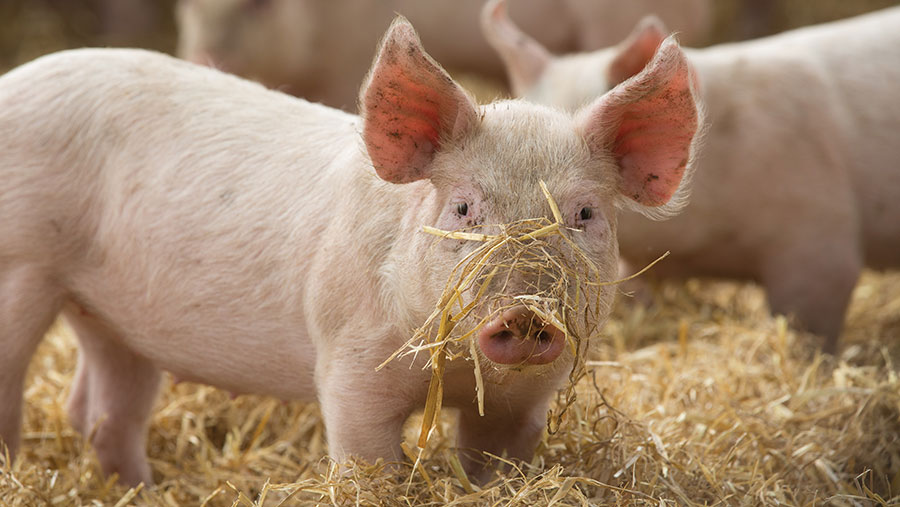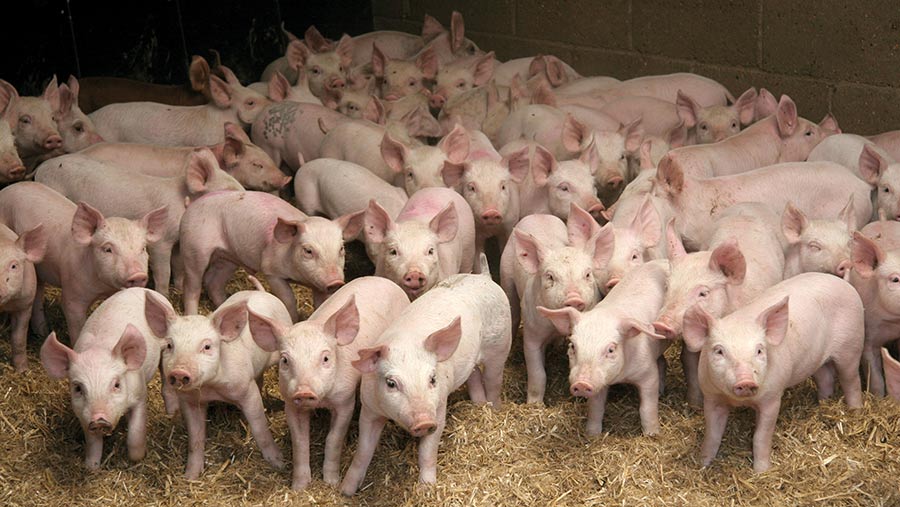Expert guide to feed and water requirements for weaners
 © Tim Scrivener
© Tim Scrivener Research has shown that good growth rates in the weaning period sets the pig up for continued strong growth until slaughter. Therefore, it is crucial to carefully. manage weaner nutrition.
Vet Christina Huelsmann-Diamond, of Farmvet Integrated Livestock Services, discussed the important steps of weaner feeding during the Principles of pig production webinar series run by the AHDB.
She explained that while the diets at this time are the most expensive of pig rations, it is also the life stage where the pig’s feed conversion is highest, so it is worth maximising.
“Faster growth in the three weeks after weaning increases growth rate right through to slaughter, so it is really important to get it right early on.”
Feed availability and space
It is important to remember what feeding was like when the piglet was with the sow – food was ad-lib and sociable.
Piglets have small stomachs, so they feed little and often and, if they were on the sow, would be able to feed from the udder at the same time.
To replicate this, feed should be always available, either through frequent feeds or giving ad-lib feed that is easily reached.
Plenty of space should be provided to allow all animals access to feed at once – 10cm of trough space for each pig for the first seven days after weaning.
Pigs should not be queueing or competing for food – this would suggest a problem with the grouping or space availability.
The flow of feed should be adjusted to give a 40% covering in the feed space – more can be overwhelming and lead to waste. Additionally, if feed is left to go rancid, it will put pigs off feeding from the trough or hopper, negatively affecting intakes.
Effect of stocking density on feed intake and growth |
|||
|
Stocking density (pigs/pen) |
8 |
12 |
16 |
|
Space allowance (sq m/pig) |
0.25 |
0.17 |
0.13 |
|
Daily feed intake (kg) (0-35 days) |
0.90 |
0.82 |
0.74 |
|
Growth rate (kg/day) (0-35 days) |
0.47 |
0.43 |
0.37 |
|
Source: Dr Lindvall |
|||
Transition
Training the gut by introducing solid food before weaning is important. Young piglets have milk-digesting enzymes, but low levels of carbohydrate-digesting enzymes. Solid food offered in the farrowing house will aid production of the latter.
Research has shown that earlier introduction of creep feed will increase the number of piglets eating creep feed when it comes to weaning.
- When creep feed was introduced at seven days of age, 80.2% of piglets were eating creep at weaning
- When creep feed was introduced at 14 days of age, 70% of piglets were eating creep at weaning.
It is really important to measure feed intake, especially in the first week after weaning, as an intake drop at this time is a key indicator of a health issue.
Any change between diets – such as moving from a starter to link diet, or from a link to grower diet – should be done gradually and, ideally, raw ingredients should be kept the same.
Sudden changes may cause intestinal problems and scours, as well as reduced feed efficiency.
Example transition between diets |
||
|
Day |
Amount of diet one fed |
Amount of diet two fed |
|
1 |
100% |
0% |
|
2 |
75% |
25% |
|
3 |
50% |
50% |
|
4 |
25% |
75% |
|
5 |
0% |
100% |
|
Source: Christina Huelsmann-Diamond |
||
Starter feeds need to be:
- Palatable – pigs have three to four times as many tastebuds as humans
- Digestible – should include cereals (oats, wheat, maize), protein and fat
- Consistently high quality
- Sweet – to mimic the sweetness of sow’s milk
- Correctly sized, if pelleted
- Stored well in bags or bins – fat will quickly go rancid if warm or moist.
Gruel feeding (meal mixed with water) can be a very good way to introduce solid food and feeding gruel several times a day can pay dividends in getting a better-quality piglet.
More detail on introduction to creep and ingredients to feed can be found in our complete guide to creep-feeding piglets.
And more information for all life stages can be found in our four-step guide to pig rations.

© Tim Scrivener
Suggested intakes
Feed intakes will vary greatly depending on animal health, diet quality, availability and feeding skills. A rough guide to total intakes of diets and daily feed intake targets can be seen below.
Feed intake rates |
|||
|
Diet type |
Pig age (days) |
Total intake of diet (kg a head) |
Daily intake (g a head a day) |
|
Starter (pre-weaning) |
10-28 |
0.25 |
15 |
|
Starter |
28-38 |
2 |
200 |
|
Creep |
38-42 |
2 |
500 |
|
Link |
42-56 |
11 |
650 |
|
Grower |
57-80 |
40 |
1,700 |
|
Source: Christina Huelsmann-Diamond |
|||
Water
Pigs that don’t drink, don’t eat. Good water drinking is required to maintain feed intakes and growth rates (see “Water specifications” below), so producers should look at:
- Cleanliness During use and proper cleaning and disinfection between batches
- Proximity Drinkers should be located for easy access
- Familiarity The nipple/bowl/trough should ideally be the same in the farrowing and weaning environment
- Amount Extra drinkers are a good idea – an ideal ratio would be one nipple for 10 pigs or one bowl for 20-30 pigs
- Heights Nipples or drinkers should be low enough for the smallest pigs in the pen to reach and adjusted as they grow
- Flow rates Need to be appropriate for weaners and checked regularly
Water specifications |
|||
|
Weight of pig |
Daily requirement of water (litres) |
Flow rate (litre/min) |
Height of drinker (mm) |
|
7-18kg |
1-1.5 |
0.3 |
250-350 |
|
19-35kg |
1.5-2 |
0.5-1 |
350-450 |
|
36-60kg |
2-5 |
1-1.5 |
500-600 |
|
61-100kg |
5-6 |
1-1.5 |
600-750 |
|
Source: Christina Huelsmann-Diamond |
|||
Acidification of water
With piglets no longer consuming milk, they do not have as much lactic acid in their stomachs. This increases gut pH, providing an ideal environment for bacteria to proliferate, which can cause post-weaning diarrhoea.
One option for countering this is to acidify the water (to a pH of no less than 4.0) for three weeks after weaning, which actually
- Makes water more palatable
- Increases water intake
- Increases feed intake
- Improves gut health.
It is also good for reducing salmonella infection, therefore reducing antibiotics use.
This can also be done via feed, but not in both water and feed at the same time. Practical considerations for acidifying the water include:
- A metering device is needed (Dosatron or Select dosers)
- A mix of lactic and formic acids should be used
- Water piping must be plastic or stainless steel to prevent corrosion.
How to calculate the feed conversion rate (FCR)
FCR = total feed fed over period (kg)/total weight gain over period (kg)
Example scenario:
176 pigs averaged 7.3kg at weaning. 35 days later, 171 pigs averaged 22.4kg.
Each pig was fed: 2kg starter, 2.5kg creep, 5kg link.
Then the total grower diet was 2,205kg. Assume the five pigs that died did so while on the grower ration.
Step 1: Calculate weight gain
End weight – 171 pigs x 22.4kg = 3,830.4kg
Start weight – 176 pigs x 7.3kg = 1,284.8kg
3,830.4 – 1,284.8kg = 2,545.6kg weight gain
Step 2: Calculate feed fed
176 pigs x (2kg starter + 2.5kg creep + 5kg link) = 1,672kg
1,672kg (starter, creep and link) + 2,205kg (grower diet) = 3,877kg total
Step 3: Calculate FCR
3,877/2,545 = 1.52kg gain/kg feed fed
